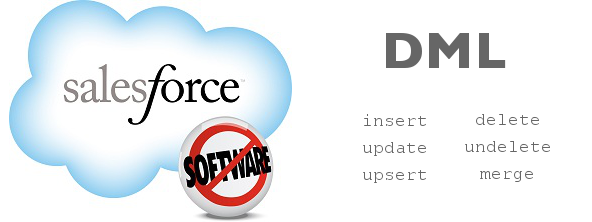Salesforce Apex DML Statements
Salesforce Apex DML (Data Manipulation Language) statements are used to Insert, Update, Merge, Delete and restore data in Salesforce. We can perform DML operations using the Apex DML statements or the methods of the Database class. We can perform 6 DML operations they are
- Insert.
- Update.
- Delete.
- UpSert.
- Merge and
- Restore.

Insert DML Statement
The insert DML operation adds one or more sObjects, such as individual accounts or contacts, to your organization’s data. insert is analogous to the INSERT statement in SQL.
Syntax
insert sObject
insert sObject[]Example
Account newAcct = new Account(name = 'Acme');
try {
insert newAcct;
} catch (DmlException e) {
// Process exception here
}Update DML Statement
The update DML operation modifies one or more existing sObject records, such as individual accounts or contacts, invoice statements, in your organization’s data. Update is analogous to the UPDATE statement in SQL.
Syntax
update sObject
update sObject[]Example
Account a = new Account(Name='Acme2');
insert(a);
Account myAcct = [SELECT Id, Name, BillingCity FROM Account WHERE Id = :a.Id];
myAcct.BillingCity = 'San Francisco';
try {
update myAcct;
} catch (DmlException e) {
// Process exception here
}
Upsert DML Statement
The upsert DML operation creates new records and updates sObject records within a single statement, using a specified field to determine the presence of existing objects, or the ID field if no field is specified.
Syntax
upsert sObject?? [opt_field]
upsert sObject[]?? [opt_field]Example
List<Account> acctList = new List<Account>();
// Fill the accounts list with some accounts
try {
upsert acctList;
} catch (DmlException e) {
}Delete DML Statement
The delete DML operation deletes one or more existing sObject records, such as individual accounts or contacts, from your organization’s data. Delete is analogous to the delete() statement in the SOAP API.
Syntax
delete sObject
delete sObject[]Example
Account[] doomedAccts = [SELECT Id, Name FROM Account
WHERE Name = 'DotCom'];
try {
delete doomedAccts;
} catch (DmlException e) {
// Process exception here
}
Undelete DML Statement
The undelete DML operation restores one or more existing sObject records, such as individual accounts or contacts, from your organization’s Recycle Bin. undelete is analogous to the UNDELETE statement in SQL.
Syntax
undelete sObject | ID
undelete sObject[] | ID[]Example
Account[] savedAccts = [SELECT Id, Name FROM Account WHERE Name = 'Universal Containers' ALL ROWS];
try {
undelete savedAccts;
} catch (DmlException e) {
// Process exception here
}Merge DML Statement
The merge statement merges up to three records of the same sObject type into one of the records, deleting the others, and re-parenting any related records.This DML operation does not have a matching Database system method.
Syntax
merge sObject sObject
merge sObject sObject[]
merge sObject ID
merge sObject ID[]Example
List<Account> ls = new List<Account>{new Account(name='Acme Inc.'),new Account(name='Acme')};
insert ls;
Account masterAcct = [SELECT Id, Name FROM Account WHERE Name = 'Acme Inc.' LIMIT 1];
Account mergeAcct = [SELECT Id, Name FROM Account WHERE Name = 'Acme' LIMIT 1];
try {
merge masterAcct mergeAcct;
} catch (DmlException e) {
// Process exception here
}
Different ways to perform DML operations.
- By using DML Statements
- By using Database Class.
By using DML Statements.
List <Account> accList = new List<Account>();
accList.add (new Account(Name='Account1'));
accList.add(new Account(Name='Account2'));
insert accList;By using Database Class.
List <Account> accList = new List<Account>();
accList.add (new Account(Name='Account1'));
accList.add(new Account(Name='Account2'));
Database.SaveResult[] Sr = Database.insert(acctList,false);As shown above, there is one difference between the two operations. In the database class method, we can specify whether to allow partial processing of the records if any errors are encountered by paring the boolean values as a parameters to Database.insert.
- If we give the parameter as ‘True’. if any error occurs it doesn’t allow the operation to continue.
- If we give the parameter as ‘false’, the remaining DML operations can still succeed. Where as insert in DML if any one of the record fails the total operation is discarded.
